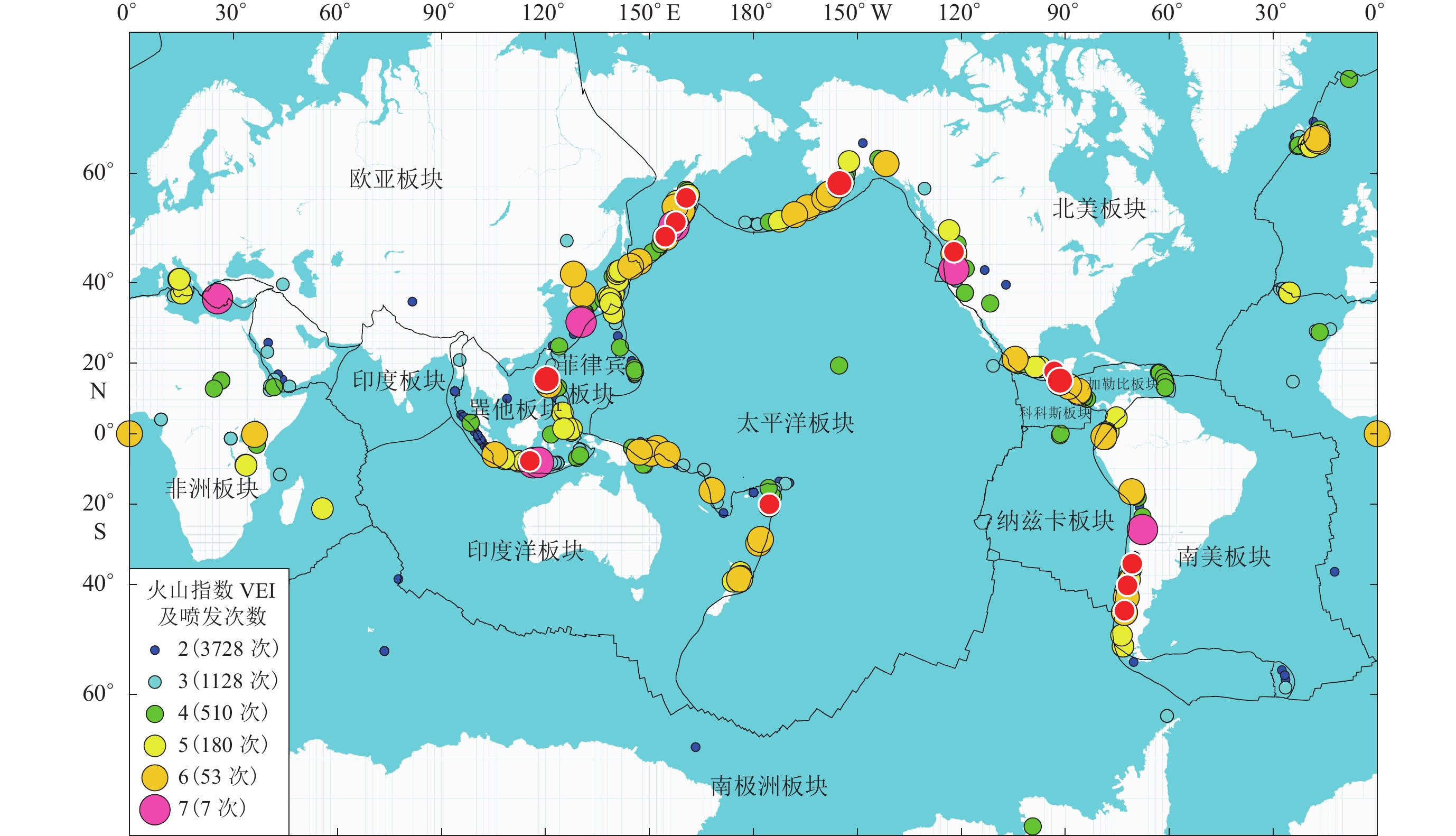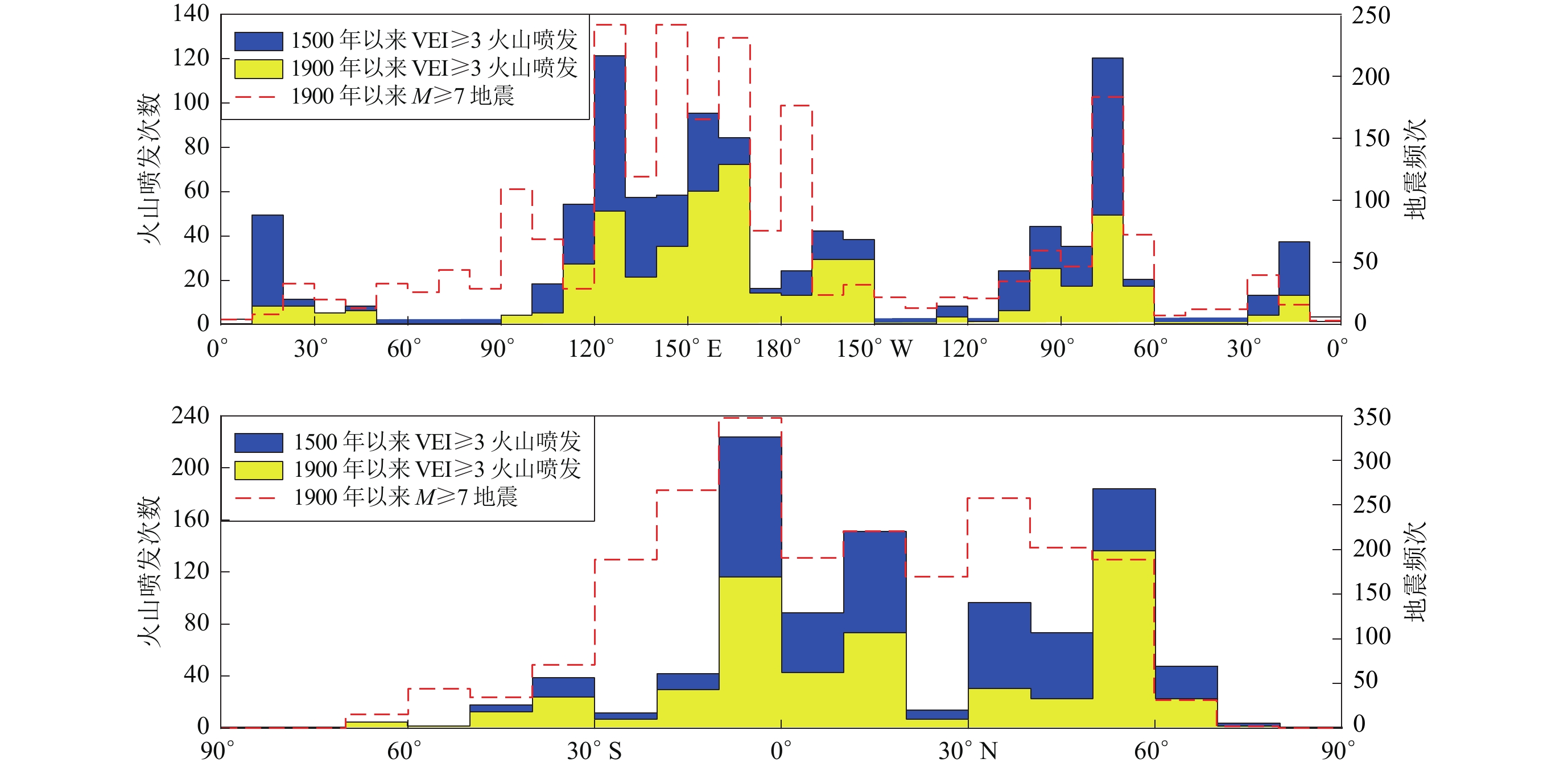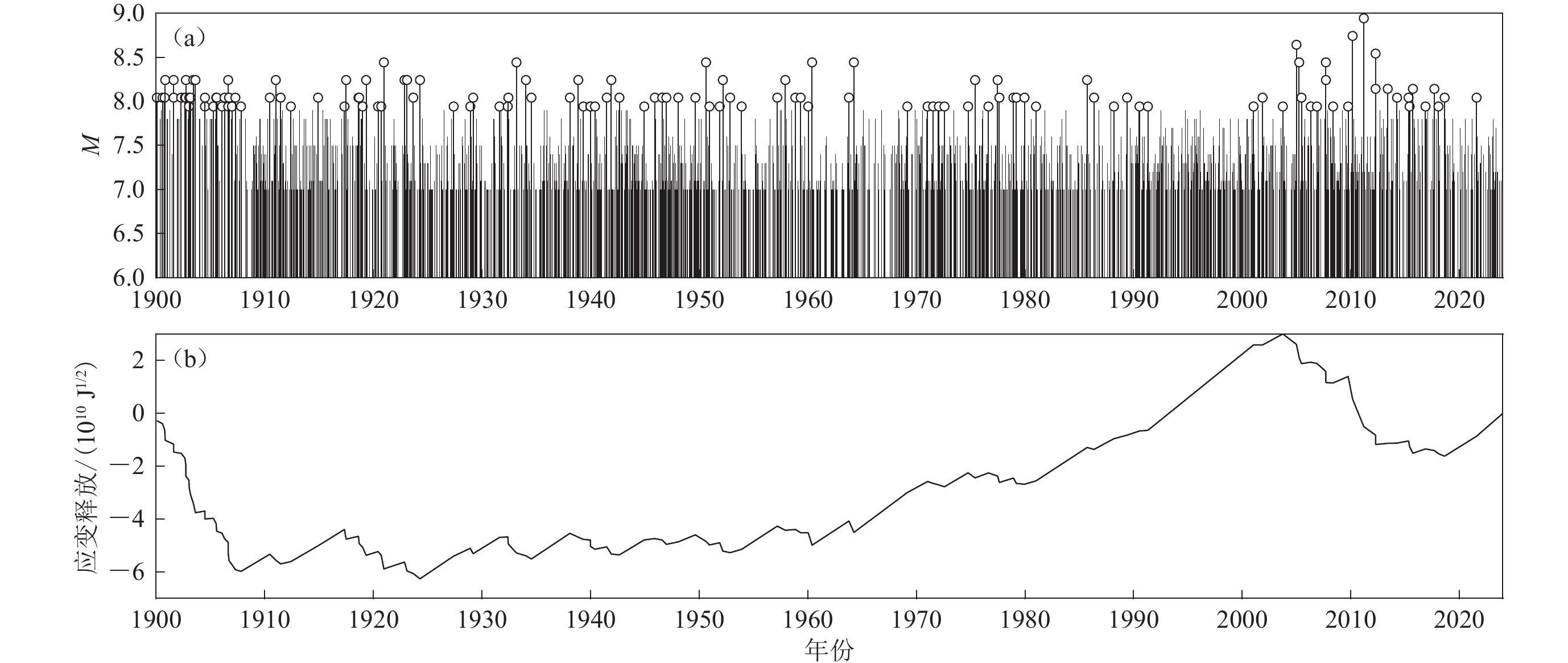Spatio-temporal distribution characteristics of the worldwide volcano activity and their implication to the strong earthquake trends
-
摘要:
基于史密森学会火山目录分析了全球火山活动的时空特征,并结合中国地震台网目录讨论了火山活动对全球和中国大陆强震活动趋势的指示意义。结果显示:① 全球火山活动表现出较为显著的百年周期特征,且百年周期内火山活动和M≥8.0大震之间存在着频次准同步和能量互补现象;② 中国大陆1955年前后强震活动状态的变化可能与同期全球火山活动状态变化密切相关,且二者可能受控于百年周期内地球内部能量积累与释放的状态变化;③ 2022年汤加火山的剧烈喷发意味着地球内部能量仍在持续释放。结合全球M8地震和中国大陆M7浅源地震的活动特征,认为当前及未来一段时间全球及中国大陆的大震活动状态可能与二十世纪上半叶相似。
Abstract:Identical with earthquakes, volcanic eruptions also play a role of energy release from the Earth’s interior. And the volcanic eruption intensity can be measured by volcanic explosivity index (VEI for short), which is determined by the volume of the eruption material and the height of the volcanic ash column. On January 15, 2022, a volcano erupted violently in Tonga in the South Pacific Ocean with the eruption intensity as high as VEI=5. And the energy release possibly exceed 58 Mt TNT, almost six times as much as the energy released by the great Wenchuan earthquake in 2008. The extremely energy release has attracted widespread attention from international scientists and has a significant impact on the global atmospheric environment and climate change.
However, as a way of energy releasing of the Earth’s interior, whether the violent eruption of the Tonga volcano was related to the state change of strong earthquake trend worldwide or in a specific tectonic region? In other words, can the extreme eruption of the Tonga volcano provide some clues or indications for the analyses of strong earthquake trend worldwide or in a specific tectonic region?
To answer this question, here, we firstly summarized the spatio-temporal features of global volcanic eruptions based on the the volcano catalogue from Smithsonian Institution and reviewed the characteristics of strong earthquake activities in the whole world and Chinese mainland on the basis of earthquake catalogue from China Earthquake Network. And then, we analyzed the possible indications of volcanic activity to the trends of global and Chinese mainland strong earthquakes in the viewpoint of the seismicity analysis. What is more, the possible change in strong earthquake trends of the whole world and Chinese mainland after the Tonga volcanic eruption is also discussed. The results are as following.
Firstly, global volcanic and seismic activities have similar characteristics on the plate scale, and they share the same main active tectonic area, called the Pacific Ring of Fire. However, there may be some certain differences in their tectonic environment. Both the volcanic eruption and strong earthquakes are more likely to occur at the boundary of the youngest (0−50 million years) plates, such as Mexico, Chile-Peru and Vanuatu, or the boundary of the oldest (more than 90 million years) plates, such as Japan and New Zealand. But, instead, the volcanic eruption and strong earthquake activity displayed opposite state in some specific tectonic regions with middle-aged (50−90 million years) plate, such as the western section of Alaska subduction and the northern section of Sumatra subduction, where large earthquakes are active but volcanism is weak.
Secondly, similar to the Gutenberg-Richter law in seismic activity, the volcanic eruption magnitude and accumulated frequency also satisfied power-law distribution. Moreover, the volcanic eruption also displayed periodic activity characteristics in time and intensity. The global volcanic activity can be divided into two visible characteristics of centennial period since 1800. In the latest centennial cycle, the strong earthquake records are complete, the energy release and cumulated frequency of volcano eruption and strong earthquakes with M≥8.0 displayed complementarity and quasi-synchronization in temporal evolution, respectively.
Thirdly, the time series of shallow earthquakes with M≥7.0 in Chinese mainland since 1900 shows that the year 1955 is a significant time-point of strong earthquake activity in Chinese mainland. Before 1955, the strong shallow earthquake activity with M≥7.0 in Chinese mainland displayed relatively random distribution in time, and the average magnitude is also relatively high; while after 1955, it showed temporal rhythmic features with obviously alternating between calm and active periods, and the average magnitude is lower than that before 1955. Similarly, global volcanism around 1955 also showed clearly segmented characteristics, which are mainly reflected in three aspects: volcanic activity intensity, frequency and energy release. Our analyses suggest that the reverse of strong earthquake activity state before and after 1955 should be related to the contemporaneous increasing of the global volcanic activity. Both of them could be attributed to the change in energy release state of the earth interior in its centennial activity period.
Finally, based on the analysis of global strong earthquake activity, we deduce that the violent eruption of the Tonga volcano may indicate that the energy release of the Earth’s interior is still ongoing. In combination with the seismicity of global earthquakes with M≥8.0 and shallow earthquakes with M≥7.0 in Chinese mainland, we deduced that the current seismicity with M≥7.0 in Chinese mainland may be similar to that in the first half of the 20th century.
Our works in this paper could provide a reference for understanding the seismological geodynamics and analyzing the related earthquake trend.
-
-
图 3 1800年以来环太平洋VEI≥4火山活动区的地震b值与板块年龄、板块汇聚速率、上伏板块相对海沟速率以及海沟深度的统计关系
蓝色方块为Nishikawa和Ide (2014)给出的关于全球大震的结果
Figure 3. Statistical relationships between seismic b value and plate age,plate convergence rate,motion rate of the overlying plate relative to trench,and trench depth in the Circum-Pacificregion with VEI≥4 volcano eruption since 1800
The blue squares are the results of global large earthquakes given by Nishikawa and Ide (2014)
图 10 全球火山活动和中国大陆M≥7.0地震活动对比
(a) 全球VEI≥4火山活动,图中蓝色矩形为5年窗长1年步长频次,红色直线为VEI≥5火山事件;(b) 中国大陆M7浅源地震,红线直线为M≥8.0地震
Figure 10. Comparison of global volcanic activities with M≥7.0 earthquakes in Chinese mainland
(a) Global volcanic eruptions with VEI≥4,where the blue rectangle is the five-year window length and one-year step length frequency,and the red lines are the volcano eruptions with VEI≥5;(b) Shallow earthquakes with M7 in Chinese mainland,where the red lines are M≥8.0 earthquakes
表 1 1900年以来强火山喷发与全球强震活动统计对比
Table 1 Comparison between strong volcanic eruptions and global strong earthquake activities since 1900
火山喷发 全球强震活动 起始时间 VEI 地点 后续三年
M7频次后续三年最大地震 后续十年
M8频次后续十年最大地震 年-月-日 地点 MS 年-月-日 地点 MS 1 902-10-24 6 危地马拉圣玛利亚 32 1 903-06-02
1 903-08-11阿拉斯加
希腊8.3
8.322 1 903-06-02
1 903-08-11
1 906-08-17
1 911-01-03阿拉斯加
希腊
智利
哈萨克斯坦8.3
8.3
8.3
8.31 907-03-28 5 俄罗斯堪察加半岛 45 1 907-04-15 墨西哥 8.1 9 1 911-01-03
1 917-06-26哈萨克斯坦
萨摩亚8.3
8.31 912-06-06 6 阿拉斯加 58 1 914-11-24 马里亚纳 8.1 11 1 920-12-16 宁夏海原 8.5 1 916-01-01 5 秘鲁赛罗阿苏尔 55 1 917-06-26 萨摩亚 8.3 13 1 920-12-16 宁夏海原 8.5 1 933-01-08 5 墨西哥科利马 54 1 933-03-02 日本本州 8.5 12 1 933-03-02 日本本州 8.5 1 955-10-22 5 俄罗斯别济米安纳 59 1 957-12-04 蒙古 8.3 8 1 960-05-22
1 964-03-28智利
阿拉斯加8.5
8.51 963-02-18 5 菲律宾阿贡 49 1 964-03-28 阿拉斯加 8.5 7 1 964-03-28 阿拉斯加 8.5 1 980-03-27 5 美国西部圣海伦斯 49 1 981-01-02 琉球群岛 8.0 6 1 985-09-19 墨西哥 8.3 1 982-03-28 5 墨西哥埃尔奇琼 48 1 983-10-05 智利 7.9 6 1 985-09-19 墨西哥 8.3 1 991-04-02 6 菲律宾吕宋 54 1 991-04-23 哥斯达黎加 8.0 3 2 001-11-14 昆仑山口西 8.1 1 991-08-08 5 智利哈德森 54 1 992-06-28 美国加州 7.9 2 2 001-11-14 昆仑山口西 8.1 2 011-06-04 5 智利南部普耶韦 67 2 012-04-11 苏门答腊 8.7 12 2 012-04-11 苏门答腊 8.6 2 021-12-20 5 汤加 24? 2 023-02-06 土耳其 7.8 ? ? 表 2 全球VEI≥5火山活动与后续三年中国大陆M7浅源地震对应情况
Table 2 Corresponding of global volcanic activity with VEI≥5 to shallow earthquakes with M7 in Chinese mainland in the following three years
火山喷发 当年中国大陆
M7浅源地震后续三年中国大陆M7浅源地震 起始时间 VEI 地点 第一年 第二年 第三年 1 902-10-24 6 危地马拉圣玛利亚 1 902-08-22
新疆阿图什MS8.11 904-08-30
四川炉霍MS7.01 907-03-28 5 俄罗斯堪察加半岛 1 908-08-20
西藏班戈MS7.01 912-06-06 6 阿拉斯加 1 913-12-21
云南峨山MS7.01 914-08-04
新疆哈密MS7.51 915-12-03
西藏曲松MS7.01 916-01-01 5 秘鲁赛罗阿苏尔 1 917-07-30
云南大关MS7.01 918-02-13
南海MS7.31 933-01-08 5 墨西哥科利马 1 933-08-25
四川茂县MS7.51 934-12-15
西藏申扎MS7.01 955-10-22 5 俄罗斯别济米安纳 1 955-04-14
四川康定MS7.51 963-02-18 5 菲律宾阿贡 1 963-04-19
青海都兰MS7.01 966-03-22
河北邢台MS7.11 980-03-27 5 美国西部圣海伦斯 1 982-03-28 5 墨西哥埃尔奇琼 1 985-08-23
新疆乌恰MS7.41 991-04-02 6 菲律宾吕宋 1 994-09-16
台湾海峡MS7.31 991-08-08 5 智利哈德森 1 994-09-16
台湾海峡MS7.32 011-06-04 5 智利南部普耶韦 2 013-04-20
四川芦山MS7.02 014-02-12
新疆于田MS7.32 021-12-20 5 汤加 2 021-05-22
青海玛多MS7.42 024-01-23
新疆乌什MS7.1 -
安利. 2020. 火山爆发强度的八个等级[J]. 百科知识,(14):28–29. An L. 2020. Eight levels of the volcanic eruption intensity[J]. Encyclopedic Knowledge,(14):28–29 (in Chinese).
安艺敬一. 2009. 预测地震和火山喷发的地震学[M]. 尹祥础,张永仙,王裕仓,周龙泉,张浪平,张晖辉等译. 北京:科学出版社:1−331. Aki K. 2009. Seismology of Earthquake and Volcano Prediction[M]. Yin X C,Zhang Y X,Wang Y C,Zhou L Q,Zhang L P,Zhang H H,et al trans. Beijing:Science Press:1−331 (in Chinese).
陈学忠,吕晓健,王慧敏. 2001. 中国大陆地震活跃期和平静期的b值与地震趋势研究[J]. 地震,21(1):59–62. Chen X Z,Lü X J,Wang H M. 2001. b value of the seismically active and quiescent periods and research of seismicity tendency in China’s continent[J]. Earthquake,21(1):59–62 (in Chinese).
邓起东,程绍平,马冀,杜鹏. 2014. 青藏高原地震活动特征及当前地震活动形势[J]. 地球物理学报,57(7):2025–2042. Deng Q D,Cheng S P,Ma J,Du P. 2014. Seismic activities and earthquake potential in the Tibetan Plateau[J]. Chinese Journal of Geophysics,57(7):2025–2042 (in Chinese).
董金龙,胡修举,邹常伟. 2015. 全球地震及火山的分布特征及其变化关系[J]. 首都师范大学学报(自然科学版),36(5):87–90. Dong J L,Hu X J,Zou C W. 2015. Distribution characteristics of global earthquakes,volcanoes and their changes in relationship[J]. Journal of Capital Normal University (Natural Sciences Edition),36(5):87–90 (in Chinese).
郭正府,刘嘉麒. 2002. 火山活动与气候变化研究进展[J]. 地球科学进展,17(4):595–604. Guo Z F,Liu J Q. 2002. Research advance in effect of volcanism on climate changes[J]. Advance in Earth Sciences,17(4):595–604 (in Chinese).
洪汉净,于泳,郑秀珍,刘培洵,陶玮. 2003. 全球火山活动分布特征[J]. 地学前缘,10(增刊):11–16. Hong H J,Yu Y,Zheng X Z,Liu P X,Tao W. 2003. Global volcano distribution:Pattern and variation[J]. Earth Science Frontiers,10(S1):11–16 (in Chinese).
洪汉净,陈会仙,赵谊,胡久常. 2009. 全球地震、火山分布及其变化特征[J]. 地震地质,31(4):573–583. doi: 10.3969/j.issn.0253-4967.2009.04.001 Hong H J,Chen H X,Zhao Y,Hu J C. 2009. Global earthquakes and volcanoes:Distribution and variations[J]. Seismology and Geology,31(4):573–583 (in Chinese).
洪汉净. 2011. 近年来全球地震与火山活动分析[J]. 自然杂志,33(5):266–270. Hong H J. 2011. Analysis on global earthquake and volcano activity in recent years[J]. Chinese Journal of Nature,33(5):266–270 (in Chinese).
刘国明,张恒荣,孔庆军. 2006. 长白山天池火山区的地震活动特征分析[J]. 地震地质,28(3):503–508. Liu G M,Zhang H R,Kong Q J. 2006. Analysis of the seismic activity at the Changbaishan Tianchi volcano[J]. Seismology and Geology,28(3):503–508 (in Chinese).
刘国明,杨景奎,王丽娟,孙纪财. 2011. 长白山火山活动状态分析[J]. 矿物岩石地球化学通报,30(4):393–399. Liu G M,Yang J K,Wang L J,Sun J C. 2011. Active level analysis of the Tianchi volcano in Changbaishan,China[J]. Bulletin of Mineralogy,Petrology and Geochemistry, 30 (4):393−399 (in Chinese).
刘嘉麒,郭正府. 1998. 火山活动与构造气候旋回[J]. 第四纪研究,18(3):222–228. Liu J Q,Guo Z F. 1998. Volcanic activities and tectonic-climatic cycles[J]. Quaternary Sciences,18(3):222–228 (in Chinese).
吕政,杨清福,张恒荣,刘国明,高金哲. 2007. 长白山天池火山地震活动与西北太平洋俯冲带内中深源地震关系的研究[J]. 地震地质,29(3):470–479. Lü Z,Yang Q F,Zhang H R,Liu G M,Gao J Z. 2007. Study of the relationship between Changbaishan Tianchi volcanic seismic activity and deep earthquakes in the Northwest Pacific subduction zone[J]. Seismology and Geology,29(3):470–479 (in Chinese).
马宏生,邵志刚,周龙泉,蒋长胜. 2009. 汶川8.0级地震后中国大陆强震活动状态研究[J]. 地震,29(4):63–71. Ma H S,Shao Z G,Zhou L Q,Jiang C S. 2009. On the state of strong earthquake activity in mainland China after the Wenchuan 8.0 earthquake[J]. Earthquake,29(4):63–71 (in Chinese).
曲维政,黄菲,杜凌,赵进平,秦婷,曹勇. 2011. 火山活动的周期性及其在若干气候要素中的反映[J]. 地球物理学报,54(3):643–655. Qu W Z,Huang F,Du L,Zhao J P,Qin T,Cao Y. 2011. The periodicity of volcano activity and its reflection in some climate factors[J]. Chinese Journal of Geophysics,54(3):643–655 (in Chinese).
邵志刚,马宏生,李志雄,张国民. 2009. 中国大陆强震活动时空特征分析[J]. 地震,29(4):98–106. Shao Z G,Ma H S,Li Z X,Zhang G M. 2009. Temporal and spatial characteristics of strong earthquake activities in Mainland China[J]. Earthquake,29(4):98–106 (in Chinese).
宋治平,张国民,刘杰,尹继尧,薛艳,宋先月. 2011. 全球地震目录[M]. 北京:地震出版社:113−448. Song Z P,Zhang G M,Liu J,Yin J Y,Xue Y,Song X Y. 2011. Global Earthquake Catalog[M]. Beijing:Seismological Press:113−448 (in Chinese).
宋治平,尹继尧,薛艳,张国民,刘杰,朱元清,张永仙. 2013. 全球及各地震区带强震活动周期特征[J]. 地球物理学报,56(6):1868–1876. Song Z P,Yin J Y,Xue Y,Zhang G M,Liu J,Zhu Y Q,Zhang Y X. 2013. The global and sub-zone period characteristics for large earthquakes[J]. Chinese Journal of Geophysics,56(6):1868–1876 (in Chinese).
孙加林,章瑞. 2007. 中国大陆20世纪以来第五地震活跃期的复杂性及其本质问题[J]. 地震,27(2):30–40. Sun J L,Zhang R. 2007. Complexity of the 5th seismic active period in Mainland China since the 20th Century and its true nature[J]. Earthquake,27(2):30–40 (in Chinese).
王凡,沈正康,王阎昭,王敏. 2011. 2011年3月11日日本宫城MW9.0级地震对其周边地区火山活动的影响[J]. 科学通报,56(14):1080–1083. Wang F,Shen Z K,Wang Y Z,Wang M. 2011. Influence of the March 11,2011 MW9.0 Tohoku-Oki earthquake on regional volcanic activities[J]. Chinese Science Bulletin,56(20):2077–2081. doi: 10.1007/s11434-011-4523-y
吴建平,明跃红,张恒荣,刘国明,房立华,苏伟,王未来. 2007. 长白山天池火山区的震群活动研究[J]. 地球物理学报,50(4):1089–1096. Wu J P,Ming Y H,Zhang H R,Liu G M,Fang L H,Su W,Wang W L. 2007. Earthquake swarm activity in Changbaishan Tianchi volcano[J]. Chinese Journal of Geophysics,50(4):1089–1096 (in Chinese). doi: 10.1002/cjg2.1126
薛艳,刘杰,姜祥华. 2021. 全球及主要构造带大震活动状态研究[J]. 地球物理学报,64(12):4425–4436. Xue Y,Liu J,Jiang X H. 2021. Process and trend of great earthquakes in the globe and main zones[J]. Chinese Journal of Geophysics,64(12):4425–4436 (in Chinese).
张国民,马宏生. 2006. 我国陆区7级地震形势分析[G]//中国大陆强震趋势预测研究(2007年度). 北京:地震出版社:59−64. Zhang G M,Ma H S. 2006. Analysis of magnitude 7 earthquake trend in Chinese mainland[G]//Forecasting Research of the Strong Earthquake Trend of Chinese Mainland in 2007. Beijing:Seismological Press:59−64 (in Chinese).
中国地震台网. 2023. 历史地震[EB/OL]. [2023-08-31]. https://www.ceic.ac.cn/history/. China Earthquake Network. 2023. Historical earthquake[EB/OL]. [2023-08-31]. https://www.ceic.ac.cn/history/ (in Chinese).
Adam D. 2022. Tonga volcano eruption created puzzling ripples in Earth’s atmosphere[J]. Nature,601(7894):497. doi: 10.1038/d41586-022-00127-1
Bao Y,Song Y J,Shu Q,He Y,Qiao F L. 2023. Tonga volcanic eruption triggered anomalous Arctic warming in early 2022[J]. Ocean Model,186:102258. doi: 10.1016/j.ocemod.2023.102258
Bell A F,Hernandez S,McCloskey J,Ruiz M,LaFemina P C,Bean C J,Möllhoff M. 2021. Dynamic earthquake triggering response tracks evolving unrest at Sierra Negra volcano,Galápagos Islands[J]. Sci Adv,7(39):eabh0894. doi: 10.1126/sciadv.abh0894
Bonadonna C,Folch A,Loughlin S,Puempel H. 2012. Future developments in modelling and monitoring of volcanic ash clouds:Outcomes from the first IAVCEI-WMO workshop on Ash Dispersal Forecast and Civil Aviation[J]. Bull Volcanol,74(1):1–10. doi: 10.1007/s00445-011-0508-6
Burgos V,Jenkins S F,Bebbington M,Newhall C,Taisne B. 2022. A new perspective on eruption data completeness:Insights from the First Recorded EruptionS in the Holocene (FRESH) database[J]. J Volcanol Geotherm Res,431:107648. doi: 10.1016/j.jvolgeores.2022.107648
Carvajal M,Sepúlveda I,Gubler A,Garreaud R. 2022. Worldwide signature of the 2022 Tonga volcanic tsunami[J]. Geophys Res Lett,49(6):e2022GL098153. doi: 10.1029/2022GL098153
Chen Y,Hu J P,Peng F. 2018. Seismological challenges in earthquake hazard reductions:Reflections on the 2008 Wenchuan earthquake[J]. Sci Bull,63(17):1159–1166. doi: 10.1016/j.scib.2018.06.015
Cottrell E. 2015. Global distribution of active volcanoes[G]//Volcanic Hazards,Risks and Disasters. Heidelberg:Elsevier:1−16.
Crampin S,Gao Y,Bukits J. 2015. A review of retrospective stress-forecasts of earthquakes and eruptions[J]. Phys Earth Planet Inter,245:76–87. doi: 10.1016/j.pepi.2015.05.008
Deligne N I,Coles S G,Sparks R S J. 2010. Recurrence rates of large explosive volcanic eruptions[J]. J Geophys Res:Solid Earth,115(B6):B06203.
Dieterich J,Cayol V,Okubo P. 2000. The use of earthquake rate changes as a stress meter at Kilauea volcano[J]. Nature,408(6811):457–460. doi: 10.1038/35044054
Eggert S,Walter T R. 2009. Volcanic activity before and after large tectonic earthquakes:Observations and statistical significance[J]. Tectonophysics,471(1/2):14–26.
Farrell J,Husen S,Smith R B. 2009. Earthquake swarm and b-value characterization of the Yellowstone volcano-tectonic system[J]. J Volcanol Geotherm Res,188(1/2/3):260–276.
Global Volcanism Program,National Museum of Natural History,Smithsonian Institution. 2023. Volcanoes of the world[DB/OL]. [2023-08-31]. https://volcano.si.edu/search_eruption.cfm/.
González G,Fujita E,Shibazaki B,Hayashida T,Chiodini G,Lucchi F,Yokoyama I,Németh K,Mora-Amador R,Moya A,Chigna G,Martí J,Rouwet D. 2021. Increment in the volcanic unrest and number of eruptions after the 2012 large earthquakes sequence in Central America[J]. Sci Rep,11(1):22417. doi: 10.1038/s41598-021-01725-1
Green D N,Neuberg J. 2006. Waveform classification of volcanic low-frequency earthquake swarms and its implication at Soufrière Hills Volcano,Montserrat[J]. J Volcanol Geotherm Res,153(1/2):51–63.
Gutenberg B,Richter C F. 1944. Frequency of earthquakes in California[J]. Bull Seismol Soc Am,34(4):185–188. doi: 10.1785/BSSA0340040185
Jenkins S,Smith C,Allen M,Grainger R. 2023. Tonga eruption increases chance of temporary surface temperature anomaly above 1.5 °C[J]. Nat Clim Chang,13(2):127–129. doi: 10.1038/s41558-022-01568-2
Kasahara J. 2002. Tides,earthquakes,and volcanoes[J]. Science,297(5580):348–349. doi: 10.1126/science.1074601
Kulichkov S N,Chunchuzov I P,Popov O E,Gorchakov G I,Mishenin A A,Perepelkin V G,Bush G A,Skorokhod A I,Vinogradov Y A,Semutnikova E G,Šepic J,Medvedev I P,Gushchin R A,Kopeikin V M,Belikov I B,Gubanova D P,Karpov A V,Tikhonov A V. 2022. Acoustic-gravity Lamb waves from the eruption of the Hunga-Tonga-Hunga-Hapai Volcano,its energy release and impact on aerosol concentrations and tsunami[J]. Pure Appl Geophys,179(5):1533–1548. doi: 10.1007/s00024-022-03046-4
Lay T. 2015. The surge of great earthquakes from 2004 to 2014[J]. Earth Planet Sc Lett,409:133–146. doi: 10.1016/j.jpgl.2014.10.047
Lemarchand N,Grasso J R. 2007. Interactions between earthquakes and volcano activity[J]. Geophys Res Lett,34(24):L24303.
Loughlin S C,Sparks S,Brown S K,Jenkins S F,Vye-Brown C. 2015. Global Volcanic Hazards and Risk[M]. Cambridge:Cambridge University Press:1−79.
Marzocchi W,Zaccarelli L. 2006. A quantitative model for the time-size distribution of eruptions[J]. J Geophys Res:Solid Earth,111(B4):B04204.
Mastin L G,Guffanti M,Servranckx R,Webley P,Barsotti S,Dean K,Durant A,Ewert J W,Neri A,Rose W I,Schneider D,Siebert L,Stunder B,Swanson G,Tupper A,Volentik A,Waythomas C F. 2009. A multidisciplinary effort to assign realistic source parameters to models of volcanic ash-cloud transport and dispersion during eruptions[J]. J Volcanol Geotherm Res,186(1/2):10–21.
Mcnutt S R,Beavan R J. 1981. Volcanic earthquakes at Pavlof Volcano correlated with the solid earth tide[J]. Nature,294(5842):615–618. doi: 10.1038/294615a0
Mellors R,Kilb D,Aliyev A,Yetirmishli G. 2007. Correlations between earthquakes and large mud volcano eruptions[J]. J Geophys Res:Solid Earth,112(B4):B04304.
Nettles M,Ekström G. 1998. Faulting mechanism of anomalous earthquakes near Bárdarbunga Volcano,Iceland[J]. J Geophys Res:Solid Earth,103(B8):17973–17983. doi: 10.1029/98JB01392
Newhall C G,Self S. 1982. The volcanic explosivity index (VEI) an estimate of explosive magnitude for historical volcanism[J]. J Geophys Res:Oceans,87(C2):1231–1238. doi: 10.1029/JC087iC02p01231
Nishikawa T,Ide S. 2014. Earthquake size distribution in subduction zones linked to slab buoyancy[J]. Nat Geosci,7(12):904–908. doi: 10.1038/ngeo2279
Nishimura T. 2017. Triggering of volcanic eruptions by large earthquakes[J]. Geophys Res Lett,44(15):7750–7756. doi: 10.1002/2017GL074579
Omira R,Ramalho R S,Kim J,González P J,Kadri U,Miranda J M,Carrilho F,Baptista M A. 2022. Global Tonga tsunami explained by a fast-moving atmospheric source[J]. Nature,609(7928):734–740. doi: 10.1038/s41586-022-04926-4
Papale P. 2018. Global time-size distribution of volcanic eruptions on Earth[J]. Sci Rep,8(1):6838. doi: 10.1038/s41598-018-25286-y
Proud S R,Prata A T,Schmauß S. 2022. The January 2022 eruption of Hunga Tonga-Hunga Ha’apai volcano reached the mesosphere[J]. Science,378(6619):554–557. doi: 10.1126/science.abo4076
Pyle D M. 2015. Sizes of volcanic eruptions[G]//The Encyclopedia of Volcanoes. 2nd ed. Amsterdam:Academic Press:257−264.
Rougier J,Sparks S R,Cashman K V. 2016. Global recording rates for large eruptions[J]. J Appl Volcanol,5:11. doi: 10.1186/s13617-016-0051-4
Schmincke H U. 2004. Volcanism[M]. Berlin:Springer-Verlag:324.
Siebert L,Simkin T,Kimberly P. 2011. Volcanoes of the World[M]. 3rd ed. Berkeley:Berkeley University of California Press:1−32.
Siebert L,Cottrell E,Venzke E,Andrews B. 2015. Earth’s volcanoes and their eruptions:An overview[G]//The Encyclopedia of Volcanoes. 2nd ed. Amsterdam:Academic Press:239−255.
Simkin T. 1993. Terrestrial volcanism in space and time[J]. Annu Rev Earth Planet Sci,21(1):427–452. doi: 10.1146/annurev.ea.21.050193.002235
Vömel H,Evan S,Tully M. 2022. Water vapor injection into the stratosphere by Hunga Tonga-Hunga Ha’apai[J]. Science,377(6613):1444–1447. doi: 10.1126/science.abq2299
Wright C J,Hindley N P,Alexander M J,Barlow M,Hoffmann L,Mitchell C N,Prata F,Bouillon M,Carstens J,Clerbaux C,Osprey S M,Powell N,Randall C E,Yue J. 2022. Surface-to-space atmospheric waves from Hunga Tonga-Hunga Ha’apai eruption[J]. Nature,609(7928):741–746. doi: 10.1038/s41586-022-05012-5
Zhang H,Wang F,Li J,Duan Y H,Zhu C W,He J Y. 2022. Potential impact of Tonga volcano eruption on global mean surface air temperature[J]. J Meteorol Res,36(1):1–5. doi: 10.1007/s13351-022-2013-6





 下载:
下载:









